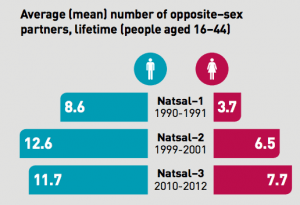Let’s talk about Natsal
By uclektm, on 28 January 2014
If you were to sum up the results of the third National Survey of Sexual Attitudes and Lifestyles (Natsal), it would go something like this: gay marriage is fine, cheating is bad and sexual behaviours can be hindered by bad health.
You could also explain the results much more eloquently, as did Professor Dame Anne Johnson (UCL Infection & Population Health) in her Lunch Hour Lecture, ‘Studying sex comes of age.’
Statistics are tricky. In theory, they should confirm what we already know empirically, but often they still manage to surprise. In this regard, I found Professor Johnson’s talk a mixed bag of expectations met and surpassed.
Why do we need Natsal?
The current Natsal is the third in a series of studies, each 10 years apart, beginning in 1990. In this way the study is unique.
It’s not just a measure of contemporary attitudes and behaviours but also a longitudinal study, capable of considering how the relationship between the UK population and sex has changed over time.
The results of the survey allow Professor Johnson and her colleagues to make key policy recommendations for Britain’s health system. So more than announcing the occasionally titillating results of Natsal, Professor Johnson was able to provide valuable insights into how healthcare ought to adapt to the changing demands of the population.
Going where no survey has gone before
As Professor Johnson characterised it, the Natsal began largely in response to the AIDS crisis. She argued that, at the time, very little was known about the transmission of AIDS, partially because very little was known about people’s sexual behaviours.
The survey can be seen as an attempt to combat a prudishness that hindered medical understanding in a time of crisis. After a hard battle to receive funding, the scope of the survey now grows bolder and wider in each of its subsequent incarnations.
The areas of enquiry in the current study included (but were not limited to) questions on heterosexual relationships, homosexual relationships and newcomer categories regarding non-volitional sex, the use of medication and sex and unplanned pregnancies.
There were also some methodological changes: the upper end of the age bracket was extended to 74 years (up from 59 in 1990 and 44 in 2000) and some participants were asked for biological samples (urine and saliva, to test for infectious diseases and testosterone levels).
The part you’ve been waiting for – the results
Professor Johnson focused on a few key areas within the study, especially those categories that were new or had changed more than others over time.
Here’s a quick summary of the results in behaviours:
- The ages between first sexual experience, first cohabitation with a partner and first children are widening. According to Professor Johnson, this makes access to contraception more vital than ever.
- People reported more sexual partners, with a more significant increase for women.
- More people reported having had same-sex experiences, and especially more women than men.
And now for attitudes:
- There has been a massive shift in attitudes towards same-sex partnerships: half of men and two-thirds of women do not think that they are ‘wrong’, which means the approval rates have nearly doubled.
- People are more disapproving of one night stands (here’s one of those surprises I was talking about – it contradicts the idea that we live in an age of sexual licentiousness).
- There is also a greater disapproval of non-exclusivity in marriage among both men (increasing from 45% to 63%) and women (from 53% to 70%).
What Professor Johnson drew from these last statistics is that people are more accepting of diversity but less accepting of ‘disrespectful’ partnerships.
In another lecture not given by a doctor and statistician, I would like to hear more investigation into what constitutes people’s idea of a disrespectful partnership.
My own pet theory (that sat with its tail between its legs during question time) is that it relates more to a rethinking of marriage that is not necessarily more ‘progressive’ despite being opened up to same-sex couples. I should have asked a question!
The final statistics related to health and sexual lifestyles:
- One in six people have a health condition that they say affects their sex life, yet only one in four people have sought help. Professor Johnson’s policy recommendation? Sexual advice should be a component of holistic healthcare.
- One in 10 women report having been forced into a non-volitional sexual experience. The good news is that the amount of people reporting these experiences to someone (police or otherwise) is rapidly increasing.
- Sexually transmitted infections (STIs) don’t necessarily come from people with multiple partners. (This was another surprise for me – the kind that involves rethinking assumptions you didn’t know you had.)
This is just a sample of the insights shared by Professor Johnson. By the end of the lecture I had an impression of her as a kind of health system superhero, identifying problems and suggesting solutions as part of a signature combo move.
That she was able to appear this way at all is probably a testament to the value of the data mined by Natsal.
You can read the published articles that discuss the latest Natsal results on the Lancet’s website. Alternatively, Natsal has published infographics to illustrate the results on the Natsal website.
The full lecture can be viewed below:
 Close
Close



